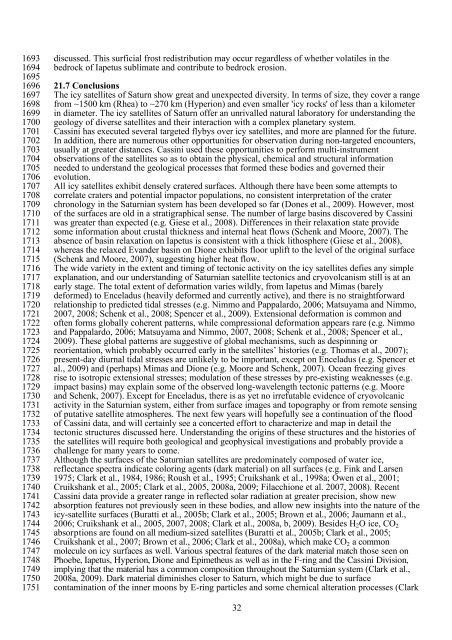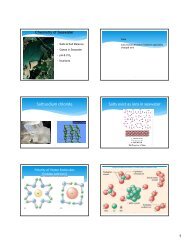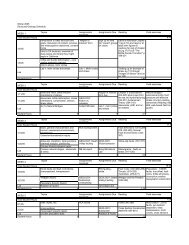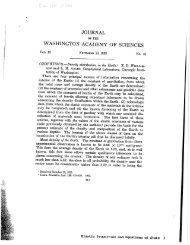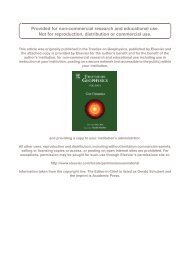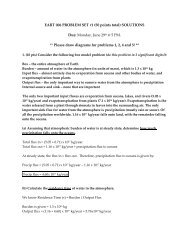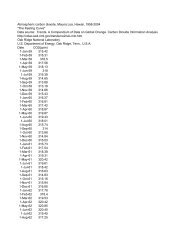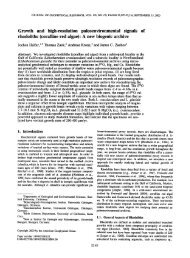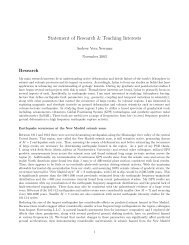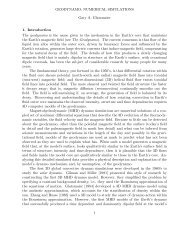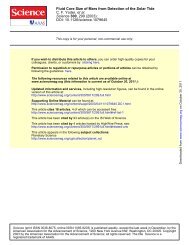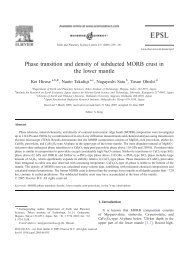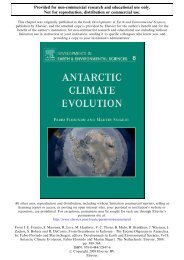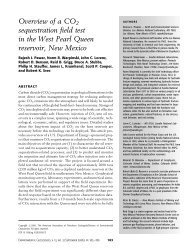Reprint - Earth & Planetary Sciences - University of California, Santa ...
Reprint - Earth & Planetary Sciences - University of California, Santa ...
Reprint - Earth & Planetary Sciences - University of California, Santa ...
Create successful ePaper yourself
Turn your PDF publications into a flip-book with our unique Google optimized e-Paper software.
1693 discussed. This surficial frost redistribution may occur regardless <strong>of</strong> whether volatiles in the<br />
1694<br />
1695<br />
bedrock <strong>of</strong> Iapetus sublimate and contribute to bedrock erosion.<br />
1696 21.7 Conclusions<br />
1697 The icy satellites <strong>of</strong> Saturn show great and unexpected diversity. In terms <strong>of</strong> size, they cover a range<br />
1698 from ~1500 km (Rhea) to ~270 km (Hyperion) and even smaller 'icy rocks' <strong>of</strong> less than a kilometer<br />
1699 in diameter. The icy satellites <strong>of</strong> Saturn <strong>of</strong>fer an unrivalled natural laboratory for understanding the<br />
1700 geology <strong>of</strong> diverse satellites and their interaction with a complex planetary system.<br />
1701 Cassini has executed several targeted flybys over icy satellites, and more are planned for the future.<br />
1702 In addition, there are numerous other opportunities for observation during non-targeted encounters,<br />
1703 usually at greater distances. Cassini used these opportunities to perform multi-instrument<br />
1704 observations <strong>of</strong> the satellites so as to obtain the physical, chemical and structural information<br />
1705 needed to understand the geological processes that formed these bodies and governed their<br />
1706 evolution.<br />
1707 All icy satellites exhibit densely cratered surfaces. Although there have been some attempts to<br />
1708 correlate craters and potential impactor populations, no consistent interpretation <strong>of</strong> the crater<br />
1709 chronology in the Saturnian system has been developed so far (Dones et al., 2009). However, most<br />
1710 <strong>of</strong> the surfaces are old in a stratigraphical sense. The number <strong>of</strong> large basins discovered by Cassini<br />
1711 was greater than expected (e.g. Giese et al., 2008). Differences in their relaxation state provide<br />
1712 some information about crustal thickness and internal heat flows (Schenk and Moore, 2007). The<br />
1713<br />
1714<br />
absence <strong>of</strong> basin relaxation on Iapetus is consistent with a thick lithosphere (Giese et al., 2008),<br />
whereas the relaxed Evander basin on Dione exhibits floor uplift to the level <strong>of</strong> the original surface<br />
1715 (Schenk and Moore, 2007), suggesting higher heat flow.<br />
1716 The wide variety in the extent and timing <strong>of</strong> tectonic activity on the icy satellites defies any simple<br />
1717 explanation, and our understanding <strong>of</strong> Saturnian satellite tectonics and cryovolcanism still is at an<br />
1718 early stage. The total extent <strong>of</strong> deformation varies wildly, from Iapetus and Mimas (barely<br />
1719 deformed) to Enceladus (heavily deformed and currently active), and there is no straightforward<br />
1720 relationship to predicted tidal stresses (e.g. Nimmo and Pappalardo, 2006; Matsuyama and Nimmo,<br />
1721 2007, 2008; Schenk et al., 2008; Spencer et al., 2009). Extensional deformation is common and<br />
1722 <strong>of</strong>ten forms globally coherent patterns, while compressional deformation appears rare (e.g. Nimmo<br />
1723 and Pappalardo, 2006; Matsuyama and Nimmo, 2007, 2008; Schenk et al., 2008; Spencer et al.,<br />
1724 2009). These global patterns are suggestive <strong>of</strong> global mechanisms, such as despinning or<br />
1725 reorientation, which probably occurred early in the satellites’ histories (e.g. Thomas et al., 2007);<br />
1726 present-day diurnal tidal stresses are unlikely to be important, except on Enceladus (e.g. Spencer et<br />
1727 al., 2009) and (perhaps) Mimas and Dione (e.g. Moore and Schenk, 2007). Ocean freezing gives<br />
1728 rise to isotropic extensional stresses; modulation <strong>of</strong> these stresses by pre-existing weaknesses (e.g.<br />
1729 impact basins) may explain some <strong>of</strong> the observed long-wavelength tectonic patterns (e.g. Moore<br />
1730 and Schenk, 2007). Except for Enceladus, there is as yet no irrefutable evidence <strong>of</strong> cryovolcanic<br />
1731 activity in the Saturnian system, either from surface images and topography or from remote sensing<br />
1732 <strong>of</strong> putative satellite atmospheres. The next few years will hopefully see a continuation <strong>of</strong> the flood<br />
1733 <strong>of</strong> Cassini data, and will certainly see a concerted effort to characterize and map in detail the<br />
1734 tectonic structures discussed here. Understanding the origins <strong>of</strong> these structures and the histories <strong>of</strong><br />
1735<br />
1736<br />
the satellites will require both geological and geophysical investigations and probably provide a<br />
challenge for many years to come.<br />
1737 Although the surfaces <strong>of</strong> the Saturnian satellites are predominately composed <strong>of</strong> water ice,<br />
1738 reflectance spectra indicate coloring agents (dark material) on all surfaces (e.g. Fink and Larsen<br />
1739 1975; Clark et al., 1984, 1986; Roush et al., 1995; Cruikshank et al., 1998a; Owen et al., 2001;<br />
1740 Cruikshank et al., 2005; Clark et al., 2005, 2008a, 2009; Filacchione et al. 2007, 2008). Recent<br />
1741 Cassini data provide a greater range in reflected solar radiation at greater precision, show new<br />
1742 absorption features not previously seen in these bodies, and allow new insights into the nature <strong>of</strong> the<br />
1743 icy-satellite surfaces (Buratti et al., 2005b; Clark et al., 2005; Brown et al., 2006; Jaumann et al.,<br />
1744<br />
1745<br />
2006; Cruikshank et al., 2005, 2007, 2008; Clark et al., 2008a, b, 2009). Besides H2O ice, CO2<br />
absorptions are found on all medium-sized satellites (Buratti et al., 2005b; Clark et al., 2005;<br />
1746<br />
1747<br />
Cruikshank et al., 2007; Brown et al., 2006; Clark et al., 2008a), which make CO2 a common<br />
molecule on icy surfaces as well. Various spectral features <strong>of</strong> the dark material match those seen on<br />
1748 Phoebe, Iapetus, Hyperion, Dione and Epimetheus as well as in the F-ring and the Cassini Division,<br />
1749 implying that the material has a common composition throughout the Saturnian system (Clark et al.,<br />
1750 2008a, 2009). Dark material diminishes closer to Saturn, which might be due to surface<br />
1751<br />
contamination <strong>of</strong> the inner moons by E-ring particles and some chemical alteration processes (Clark<br />
32


